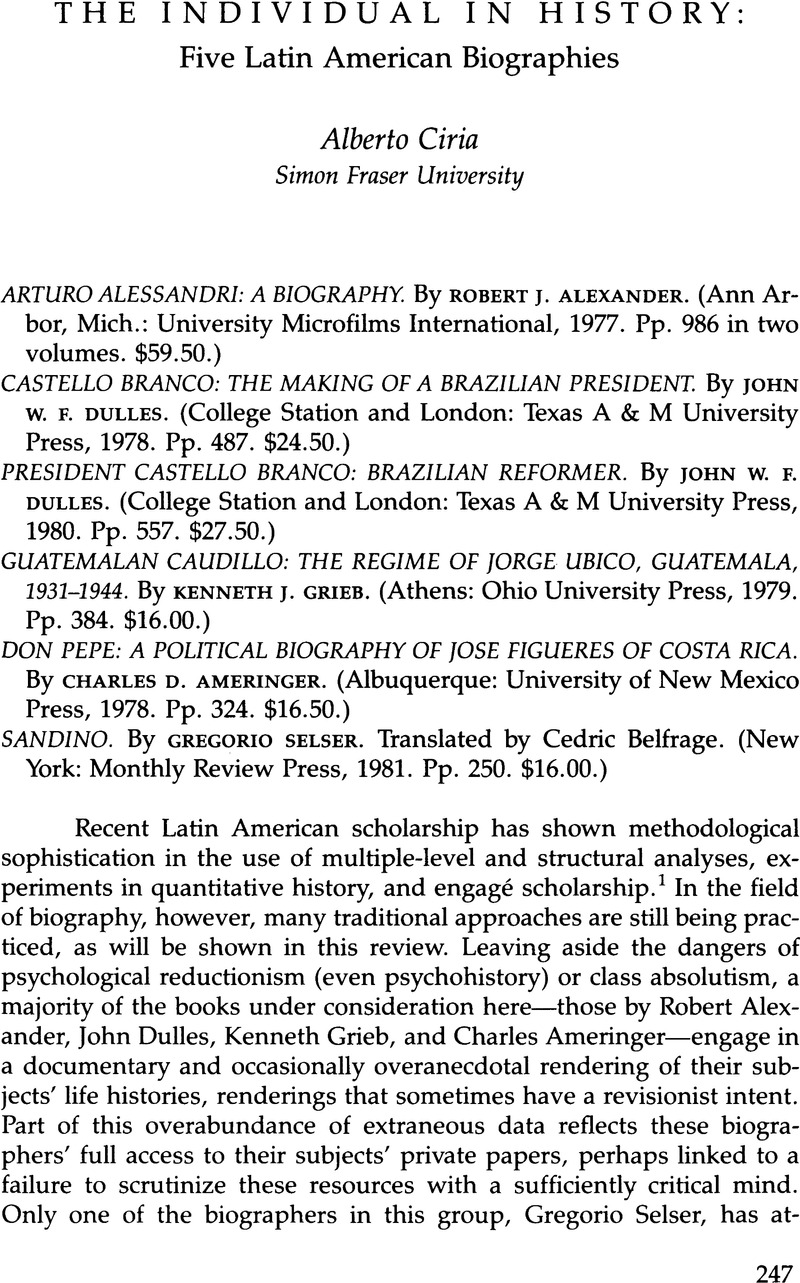No CrossRef data available.
Published online by Cambridge University Press: 12 October 2022

1. See Joseph S. Tulchin, “Emerging Patterns of Research in the Study of Latin America,” LARR 18, no. 1:85-94.
2. On the Chilean military, see Frederick M. Nunn, Chilean Politics, 1920-1931: The Honorable Mission of the Armed Forces (Albuquerque: University of New Mexico Press, 1970); and The Military in Chilean History: Essays on Civil-Military Relations, 1810-1973 (Albuquerque: University of New Mexico Press, 1976). On Chilean socialism during Alessandri's last two decades, see Paul W. Drake, Socialism and Populism in Chile, 1932-52 (Urbana: University of Illinois Press, 1978).
3. Alexander spends seventy pages explaining this attempt at armed insurrection that linked the Nazistas with Ibáñez's supporters. The discrepancy of sources on the key question as to what specific orders Alessandri gave to his commander of carabineros to reestablish public order, which resulted in the death of sixty rebels, is not really
dealt with by Alexander. Nor is the president's role clarified by Alexander's statement that he was “symbolically responsible” for the massacre (p. 707).
4. Retired General Vernon Walters, special roving ambassador for U.S. President Reagan and since 1985 U. S. Ambassador to the United Nations, is one of the most interesting secondary characters in Castello's biography. Walters was U.S. Army Assistant Attaché in Brazil from 1945 to 1948 (1:189) and was appointed U.S. Defense Attaché in October 1962 (1:276). His relationship with Castello was very friendly before and during the latter's presidency. Later on, Walters became CIA Deputy Director during the Watergate affair and published a bowdlerized autobiography, Silent Missions (New York: Doubleday, 1978). His confidential adventures made headlines as recently as the 1982 Malvinas/Falklands war; see Oscar R. Cardoso, Ricardo Kirschbaum, and Eduardo van der Koy, Malvinas: la trama secreta (Buenos Aires: Sudamérica-Planeta, 1983).
5. This person is the same Roberto Campos who contributed a laudatory foreword to Dulles's first volume (l:xi-xvii).
6. An introduction to these and related topics is found in Kenneth P. Erickson, The Brazilian Corporative State and Working Class Politics (Berkeley: University of California Press, 1977); Jan Knippers Black, United States Penetration of Brazil (Philadelphia: University of Pennsylvania Press, 1977); Peter Flynn, Brazil: A Political Analysis (Boulder, Colo.: Westview Press, 1978); and Authoritarian Capitalism: Brazil's Contemporary Economic and Political Development, edited by Thomas C. Bruneau and Philippe Faucher (Boulder, Colo.: Westview Press, 1981).
7. Curiously enough, the CIA reported on the lack of camaraderie between the U.S. military and Costa e Silva, who did not serve with the FEB in the Second World War (2:442).
8. A revisionist evaluation is Michael C. Meyer, Huerta: A Political Portrait (Lincoln: University of Nebraska Press, 1972; Spanish translation, 1983). On the theme of the dictator in Latin American novels, see Roberto González Echevarría, “The Dictatorship of Rhetoric/The Rhetoric of Dictatorship: Carpentier, García Márquez, and Roa Bastos,” LARR 15, no. 3:205-28; and Jorge Castellanos and Miguel A. Martínez, “El dictador latinoamericano como personaje literario,” LARR 16, no. 2:79-105.
9. An introduction to these topics from a radical standpoint is the excellent volume edited by Susanne Jonas and David Tobis, Guatemala (NACLA: Berkeley and New York, 1974).
10. Grieb provides a bibliographical essay describing the primary sources utilized in his study (343-63). They include U.S. State Department papers, the archives of the Guatemalan Ministry of Foreign Relations, interviews with former officials and Ubico's associates, and local newspapers. The important books by Luis Cardoza y Aragón, Manuel Galich, and Guillermo Toriello are cited but not really incorporated into the discussion of the 1944 revolution.
11. A companion piece to this biography is Charles D. Ameringer, Democracy in Costa Rica (New York: Praeger, 1982).
12. Ameringer's biography introduces characters such as fund-raiser Sacha Volman and CIA operative Cord Meyer, who at times played suggestive roles in Figueres's activities, with the latter's knowledge.
13. On statistical evidence that Costa Rica is not “a land of farmers” but in fact a country where land redistribution is extremely skewed, see “Behind the Myth of Rural Equality,” Latin American Weekly Report, WR-83-38, 30 September 1983, pp. 10-11. For President Luis Alberto Monge's comments on the difficulties of a perpetual Costa Rican neutrality, see “Nous méritons d'être aidés autant sinon plus que le Nicaragua,” Le Monde, 22 May 1984, p. 5. The crisis of the Figueres's model for Costa Rica is appraised in Marc Edelman, “Costa Rica: Seesaw Democracy,” NACLA Report on the Americas 17, no. 6 (Nov.-Dec. 1983):40-43.
14. In May 1958, Gregorio Selser, representing the major organization of university students in Buenos Aires, queried Vice President Richard Nixon about U.S. participation in the 1954 overthrow of Guatemala's Jacobo Arbenz. Nixon, who was attending the presidential inauguration of Arturo Frondizi, responded in the negative and emphasized the “Communist conspiracy” theme. His words were translated into Spanish by Colonel Vernon Walters, a key Nixon aide on the occasion (see note 4). Selser's El guatemalazo: la primera guerra sucia (Buenos Aires: Iguazú, 1961) substantiated the extent of U.S. participation in Guatemalan affairs.
15. For the differences between Sandino and the Salvadoran Communist Agustín Farabundo Martí, for instance, see Neill Macaulay, The Sandino Affair (Chicago: Quadrangle Books, 1967), especially pp. 160 and 226.
16. Among the books Selser utilized are Scott Nearing and Joseph Freeman, Dollar Diplomacy (New York: Monthly Review Press, 1966; originally published in 1926); Charles D. Kepner, Jr., and Jay H. Southill, Banana Empire: A Case Study of Economic Imperialism (New York: Russell, 1967; originally published in 1935); George Seldes, One Thousand Americans (New York: Boni & Gaer, 1948); William Krehm, Democracia y tiranías en el Caribe (Mexico: Unión Democrática Centroamericana, 1951); John Kenneth Turner, Shall It Be Again? (New York: B. W. Huebsch, 1922); and Carleton Beals, America South (Philadephia: J. B. Lippincott, 1937).